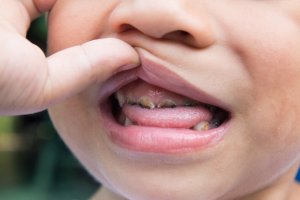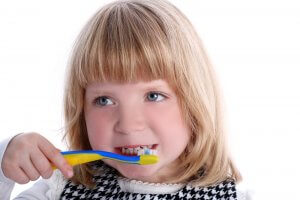Has your child’s dentist recommend that they have fluoride varnish applied to their teeth? Or perhaps you’re looking into the options for yourself as an adult and want to know more about the benefits and potential risks of fluoride varnish.
This treatment is widely used as a preventative measure against dental caries (tooth decay). It’s routinely offered to children in the UK on the NHS but can be used on adults as well. Although it has been proven to be very effective, it’s natural you want to understand more before going ahead.
In this article you can read about:
- The benefits of fluoride varnish for adults and children
- Possible risks and side effects of the treatment
- The fluoride varnish application procedure
- How much fluoride varnish costs on the NHS and privately
We hope this helps you decide whether to go ahead with the treatment, whether for your child’s dental health or for yourself.
What is fluoride varnish?

Fluoride varnish is, as the name suggests, a liquid which contains a high concentration of fluoride. It may also come in the form of a gel. A thin layer is applied directly to the teeth. It then hardens and releases fluoride into the enamel.
Fluoride is a mineral which helps strengthen tooth enamel, thereby making teeth more resistant to decay. Fluoride is added to the water supply in some areas, and is found in many children’s toothpastes.
Benefits of fluoride varnish
Tooth decay in children is a big problem throughout the world. In the UK, almost half of children have some decay by age 8, and it affects a third of 5-year-olds.
Fluoride varnish treatment has been proven to reduce the prevalence of dental caries in milk teeth by 37% and permanent teeth by 43%, according to this Cochrane review. It’s particularly effective for children who are at high risk of decay and who are not exposed to fluoride from other sources.

Applying fluoride varnish can also help reverse early signs of tooth decay (white spot lesions), as examined in this clinical trial.
Fluoride varnish treatment is quick, simple, and non-invasive. It must be carried out by a dental professional, but doesn’t need to be done in a dentist’s office. It might be carried out at your child’s school or nursery, for example, as part of a community program. This can make it less daunting than being treated in the dentist’s chair.
Another preventative treatment often offered to children with permanent teeth is fissure sealant. This fills in deep grooves and pits in the biting surfaces of the teeth, making them easier to clean and reducing the chances of decay.
Fluoride varnish risks and side effects
Although fluoride varnish is a very safe and widely practised treatment, it is not suitable for everyone.
One of the risks of over-exposure to fluoride is dental fluorosis, a condition which results in discolouration or white spots on the teeth while they are developing. The amount of fluoride exposure from varnish treatment shouldn’t pose a significant risk because it is applied topically, not ingested.
That said, do make sure your child spits out all excess toothpaste after brushing – especially in the days following fluoride varnish treatment. If they regularly swallow fluoride toothpaste, the risk of fluorosis increases.

If you or your child take fluoride drops or tablets, mention this before receiving treatment. You may be advised not to have fluoride varnish at all, or to stop taking the other supplement for a few days after the varnish is applied.
Patients with a medical history of allergies should be individually assessed before treatment to reduce the risk of fluoride varnish side effects. Specifically, patients may not be treated if they have allergies to sticking plaster (which contains colophony, also found in duraphat fluoride varnish) or food allergies or asthma which have resulted in hospitalisation.
Finally, if you or your child have any mouth sores or ulcers on the day of treatment then it will probably be postponed.
Fluoride varnish for adults
Although it’s routinely offered to children in the UK, fluoride varnish can also be beneficial for adults. Specifically, the treatment may be recommended for adults who:
- Suffer from sensitive teeth
- Have thin tooth enamel or significant enamel erosion, for example from teeth grinding
- Have chronic tooth decay
Mention it to your dentist at your next visit if you think you might benefit.
Fluoride varnish application
Fluoride varnish treatment can be carried out as soon as a baby’s first milk tooth appears. The NHS recommends that children are treated every six months from age 3. Dentists may recommend more frequent treatment for children who already have tooth decay or are at high risk of developing it.

The application process differs a little for children and adults. For children, it usually involves drying the teeth with a cotton wool roll and then applying the varnish with a small brush to coat the teeth. For adults, the dentist may first perform a teeth cleaning to remove all plaque from the teeth, before drying them and applying the varnish.
In any case, the fluoride varnish application itself should take no more than a minute or two, and it is completely pain-free.
Fluoride varnish has a pleasant, fruity taste and smell, and it sets quickly once applied to the teeth. The varnish has a golden yellow colour, which means that the teeth may appear yellow for a while after application. Don’t worry, this colour will fade after a day or two and won’t stain teeth permanently.
Fluoride applications have been around for many years. As a student in 1980, I applied fluoride gel in trays. Children would sit for a while with fluoride trays in their mouths, and dribble a lot. More recently, regular applications of fluoride varnish are preferred to sealants since the application procedure is tolerated by children better.
It’s simple to apply the varnish and give the child a reward, making it a positive, relatively pleasant experience for both the child and their parent. It has to be repeated regularly, and the majority of children enjoy it, even demand it.
As we get older, our mouths become drier, and root decay more likely—a higher concentration of fluoride in toothpaste helps, especially when cleaning your teeth at night. Our saliva content and quantity changes, and some kinds of toothpaste may help with the loss of protective mineral content that the saliva provided.
Dr. Antony Smith BDS, DPDS
After application
For the varnish to be most effective, you or your child may be instructed to:
- Avoid eating or drinking anything for 30 minutes following treatment
- Wait until the next morning before brushing your teeth
- Avoid crunchy, hard and chewy foods for the rest of the day, since these can scrape some of the varnish off
- Eat and drink only cold and warm foods and drinks – nothing hot
The next day, you can go back to eating and brushing your teeth as normal.
These are general guidelines only; you should follow any other advice given by the dentist or nurse administering the treatment.
In the video below you can see how fluoride varnish is applied:
How long does fluoride varnish last?
The varnish will start to wear away when you brush your teeth and will be completely gone within a few days. By then, the fluoride has already penetrated the dental enamel. It will continue to protect the teeth for several months.

Fluoride varnish should be re-applied every six months, or sooner if recommended by your dentist.
You should not rely on fluoride varnish alone to keep teeth healthy. It’s important to brush twice a day using a fluoride toothpaste and age-suitable kids toothbrush, and minimise consumption of sugary snacks and drinks. You can read more information and tips for protecting children’s teeth against decay in our separate guide.
What does fluoride varnish cost?
As well as being easy to apply and pain-free, fluoride varnish is also one of the cheapest treatments around. Those under 18 can even get them on the NHS for free.
Getting fluoride varnish on the NHS
Children and teens who get fluoride varnish on the NHS will receive it for free. Programs run through schools will also be free of charge. For adults aged 18 and over, the band 1 treatment charge will apply at an NHS dentist.
Paying privately
If your child receives private dental care, fluoride treatment may well be included as part of their regular dental checkups. If paid for separately, fees start from as little as £10-15, but of course costs vary from one dentist to the next.
As a preventative treatment, fluoride varnish is included in many dental insurance plans. Check your plan details to see if you’re covered.
Can you buy fluoride varnish to apply at home?
It is possible to buy fluoride varnish online, but we don’t recommend it. Without a proper assessment and treatment from a dental professional, you risk exposing yourself or your child to unsafe levels of fluoride and experiencing side effects.
Conclusion
Fluoride varnish application is an effective way to prevent tooth decay and remineralise teeth, for both children and adults. Children can receive free fluoride varnish treatment on the NHS and through community programs at schools.
Risks associated with this treatment are minimal, but your dentist will carry out an assessment before applying the varnish.
Treatment should accompany proper teeth brushing and good oral hygiene to keep teeth in the best condition possible.
Karger: Efficacy of Fluoride Varnish and Casein Phosphopeptide-Amorphous Calcium Phosphate for Remineralization of Primary Teeth: A Randomized Clinical Trial. Consulted 14th November 2019.
Cochrane: Fluoride varnishes for preventing dental caries in children and adolescents. Consulted 14th November 2019.




